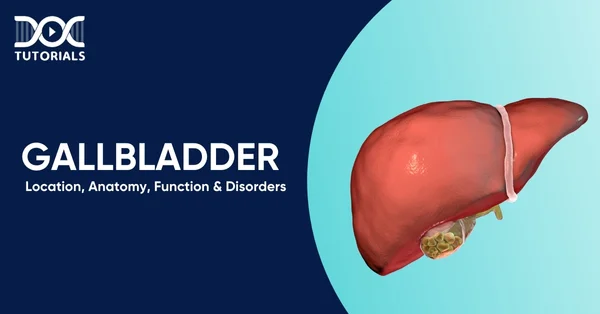Gallbladder |Location, Anatomy, Function & Disorders

The gallbladder in the human body is not a large organ by itself. Still, it plays a significant role in contributing to the body’s efficiency in digestion. Its location is under the safety of the liver, and it is crucial for supplying bile at the right moment, especially with the intake of fatty food.
A comprehensive understanding of the gallbladder anatomy, from the innervation to the blood supply, is crucial for NEET PG aspirants. It will not only help them in exam preparation, but also aid in correct diagnoses in clinical settings.
Keep reading this guide for in-depth insight!
What is the Gallbladder?
Positioned under the liver on the right side of the abdomen, the gallbladder is a compact organ with a distinct pear-like shape. It collects and thickens the bile, which is a digestive juice secreted by the liver that aids the digestion of fats in the small intestine.
When food, particularly fat-rich food, enters the digestive tract, the gallbladder contracts and releases stored bile into the small intestine through the bile ducts to aid in fat digestion.
Though not required for life, the gallbladder is a facilitative organ in digestion. If ill or causing the formation of gallstones, then it must be removed. Individuals without a gallbladder will still be able to digest, but not as much.
What is the Gallbladder Location in the Body?
The gallbladder location in the body is within the right hypochondriac area, specifically on the underside of the right lobe of the liver.
- Below the Liver in the Gallbladder Fossa
The gallbladder rests in a shallow groove on the underside of the liver, where it is securely positioned.
- Located Close to the Ninth Costal Cartilage at the Midclavicular Line
This location is useful in clinical palpation and radiologic imaging interpretation.
- Anterior to the Duodenum and Transverse Colon
Knowledge of these anatomic relationships is important during operations like cholecystectomy.
What is the Anatomy of the Gallbladder?
The gallbladder anatomy consists of three distinct parts, the fundus, body, and neck, along with several histological layers. It possesses a distinctive role in every part of bile storage function, concentration, and delivery, and is therefore a critical structure in hepatobiliary anatomy.
Here is a detailed overview:
- Fundus
The gallbladder’s fundus is its rounded, expanded front portion that extends slightly beyond the inferior margin of the liver. It tends to rest against the anterior abdominal wall close to the ninth costal cartilage. The region is easily seen on imaging devices such as ultrasound, particularly when the gallbladder is distended.
- Body
The body of the gallbladder is most developed and is situated in a superficial depression on the visceral surface of the liver. It is firmly adherent to the liver parenchyma and is the principal reservoir of bile. It also plays a part in the passive diffusion of material between the liver and gallbladder, such as the alteration of bile.
- Neck
The neck is the slender, funnel-shaped part of the gallbladder that joins the cystic duct. It has a mucosal fold, Heister’s valve, that assists in bile regulation. During digestion, bile flows from the gallbladder’s neck into the cystic duct, continuing its path toward the common bile duct without obstruction.
These three parts of the gallbladder are integral to its bile storage and release functions.
What is the Innervation of the Gallbladder?
The gallbladder receives dual innervation from sympathetic and parasympathetic nerves, which determine its ability to contract and relax:
- Parasympathetic Innervation
The gallbladder’s parasympathetic innervation occurs through the vagus nerve (cranial nerve X). Stimulation of parasympathetic fibres contracts the gallbladder to pour bile into the cystic duct and subsequently into the duodenum.
- Sympathetic Innervation
Originates from the celiac plexus and the thoracic splanchnic nerves. Relaxation of the gallbladder and contraction of the sphincter of Oddi are caused by sympathetic stimulation, regulating bile flow.
- Sensory Innervation
The gallbladder sensory nerves accompany sympathetic fibres and are involved in the transmission of pain, frequently referred to as the right upper quadrant or shoulder, with gallbladder disease.
How Does Blood Supply Occur in the Gallbladder?
The main source of arterial and venous blood flow to the gallbladder comes from:
- Arterial Supply
The cystic artery, typically a branch of the right hepatic artery, supplies oxygenated blood to the gallbladder. It can vary, but the dominant vessel is the cystic artery.
- Venous Drainage
Venous blood from the gallbladder is directly drained by small veins into the hepatic portal system. Several veins directly empty into hepatic sinusoids.
What are the 10 Functions of the Gallbladder?
Here’s a list of 10 functions of the gallbladder, which provides a clearer picture of its physiological role in digestion and metabolic homeostasis:
- Storage of Bile
The gallbladder is a tiny reservoir containing about 30-50 ml of stored bile between meals. This role provides an instantaneous availability of bile upon the arrival of food in the small intestine, especially during fat digestion.
- Concentration of Bile
Excretion of water and electrolytes to concentrate the bile is one of the simplest functions of the gall bladder. This renders the bile 5-10 times more concentrated than bile secreted initially by the liver, becoming more effective in fat digestion.
- Facilitates Lipid Digestion
Another function of the gallbladder in the digestive system becomes apparent when it secretes concentrated bile into the duodenum, where it emulsifies fats, breaks them down into minute droplets, and makes them available for digestive enzymes to act upon them.
- Regulates Bile Flow
The gallbladder does not continuously spill bile. It controls the efflux of bile into the intestine by coordinating with the sphincter of Oddi, which opens on a hormonal stimulus when fatty food is consumed.
- Helps in the Absorption of Vitamins
Fat-soluble vitamins (A, D, E, and K) rely on the gallbladder function in the digestive system for their absorption. Bile is necessary for these vitamins to be emulsified and taken up by the small intestine.
- Helps Excrete Bilirubin and Cholesterol
Secreted and stored bile acts as a vehicle of transport for bilirubin, a residue of the breakdown of red blood cells, and cholesterol. These waste materials are eliminated from the body through the intestines.
- Maintains Biliary Pressure
The gallbladder regulates intra-biliary pressure to store and release bile properly without damage and pressure-induced reflux along the biliary tract.
- Buffers Acidic Chyme
Bile released from the gallbladder into the human body is also used to neutralise the acidic chyme of the stomach, thus creating an ideal condition for enzyme action in the small intestine.
- Prevents the Overgrowth of Bacteria
The functions of the gallbladder also include microbial regulation. Bile salts have antimicrobial properties, which help prevent bacterial overgrowth in the small intestine and maintain gut flora balance.
- Acts as a Reservoir During Fasting
When fasting or between meals, the gallbladder is filled with stored bile rather than initiating bile secretion. The reservoir mechanism supplies a sudden source of bile on demand for digestion and illustrates its adaptive function in adjusting metabolism patterns.
What are the Common Disorders Related to the Gallbladder?
Knowledge of gallbladder disease is critical to the diagnosis of many abdominal illnesses, particularly in patients presenting with upper right quadrant pain, jaundice, or gastrointestinal distress. These conditions most commonly need to utilise a combination of clinical evaluation and imaging technologies for diagnosis.
The common gallbladder disorders are as follows:
- Cholelithiasis (Gallstones)
Gallstones are hard concretions that develop when bile constituents, most commonly cholesterol or bilirubin, crystallise. These stones develop when the composition of bile constituents is deranged, resulting in supersaturation and gallstones in the gallbladder.
- Cholecystitis
Cholecystitis is a frequent complication of cholelithiasis, where a stone causes cystic duct obstruction, bile collection, gallbladder inflammation, and infection.
Common symptoms are fever, postprandial right upper quadrant abdominal pain after fatty foods, and vomiting.
- Choledocholithiasis
A condition of gallstones within the common bile duct rather than the gallbladder. It may cause obstruction of bile flow from the liver as well as the gallbladder, with critical downstream effects.
- Gallbladder Carcinoma
While gallbladder carcinoma is unusual, it is usually diagnosed late in its course since its symptoms are nonspecific. It can spread quickly to the liver and surrounding organs.
The risk of developing this cancer is significantly heightened by conditions such as porcelain gallbladder (a calcification of the gallbladder wall), chronic inflammation, and long-standing gallstones.
FAQs About Gallbladder Anatomy
- Where is the gallbladder located in the body?
The gallbladder is located under the right lobe of the liver in the right hypochondriac region, near the ninth costal cartilage.
- What are the major gallbladder parts?
The gallbladder is made up of the fundus, body, and neck, which all contribute to storing and transporting bile.
- What is the primary gall bladder function?
The main gall bladder function is to store, concentrate, and release bile for fat digestion in the small intestine.
- What blood vessel supplies the gallbladder?
The cystic artery, usually branching from the right hepatic artery, supplies the gallbladder.
- Can digestion occur without a gallbladder?
Yes, digestion can still occur without a gallbladder, although bile flows less efficiently, especially after fatty meals.
Conclusion
The gallbladder plays a crucial role in digestion by regulating bile and aiding in fat breakdown. Its position underneath the liver, an independent anatomical structure, and its functions, such as bile concentration and secretion, make the gallbladder a vital topic among NEET PG aspirants. Knowledge about gallbladder location, blood supply, innervation, and pathology, such as cholelithiasis, gives clinical knowledge an extra level of depth. DocTutorials is a perfect place to understand and be confident about learning topics such as gallbladder anatomy and gall bladder diagram for comprehensive and organised learning.
We offer concise video lectures, mock tests, faculty-reviewed question banks, and more, ensuring you get all the assistance you need to ace the examination. Try DocTutorials today to excel in your NEET PG exam preparation!
Latest Blogs
-

NEET SS Exam 2024: Analysis, Key Dates, Counselling
The NEET SS 2024 exam kicked off on March 29, 2025. Over two days and two slots, candidates across 13…
-

NEET PG Registration 2025: An Essential Guide For Exam Prep
The NEET PG registration, which is conducted online, is a crucial step in the exam process. Filling out the NEET…
-

NEET PG Syllabus 2026: A Must-Have Complete Guide for Exam Success
The NEET PG Syllabus acts as one of the foundation stones for aspiring postgraduate medical students like you who are…




